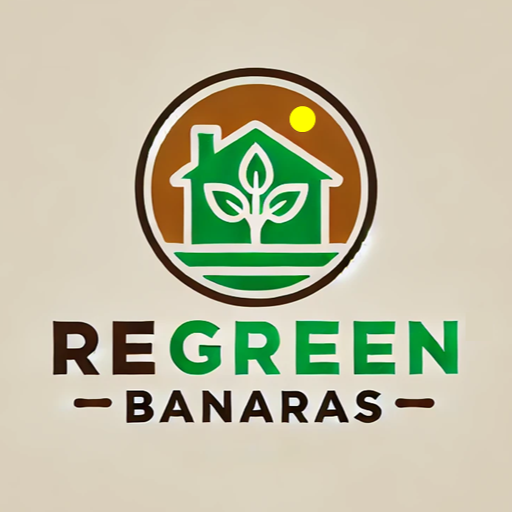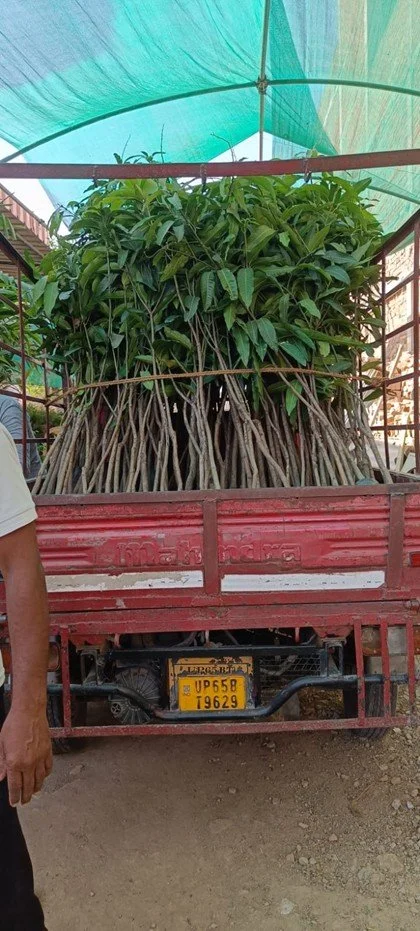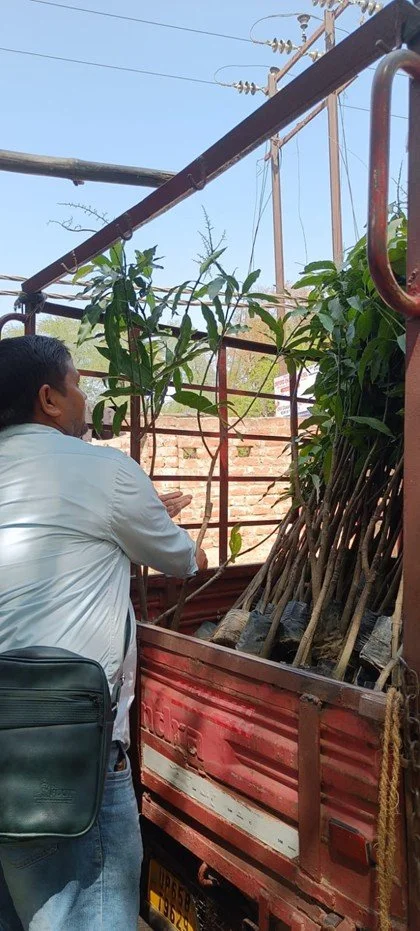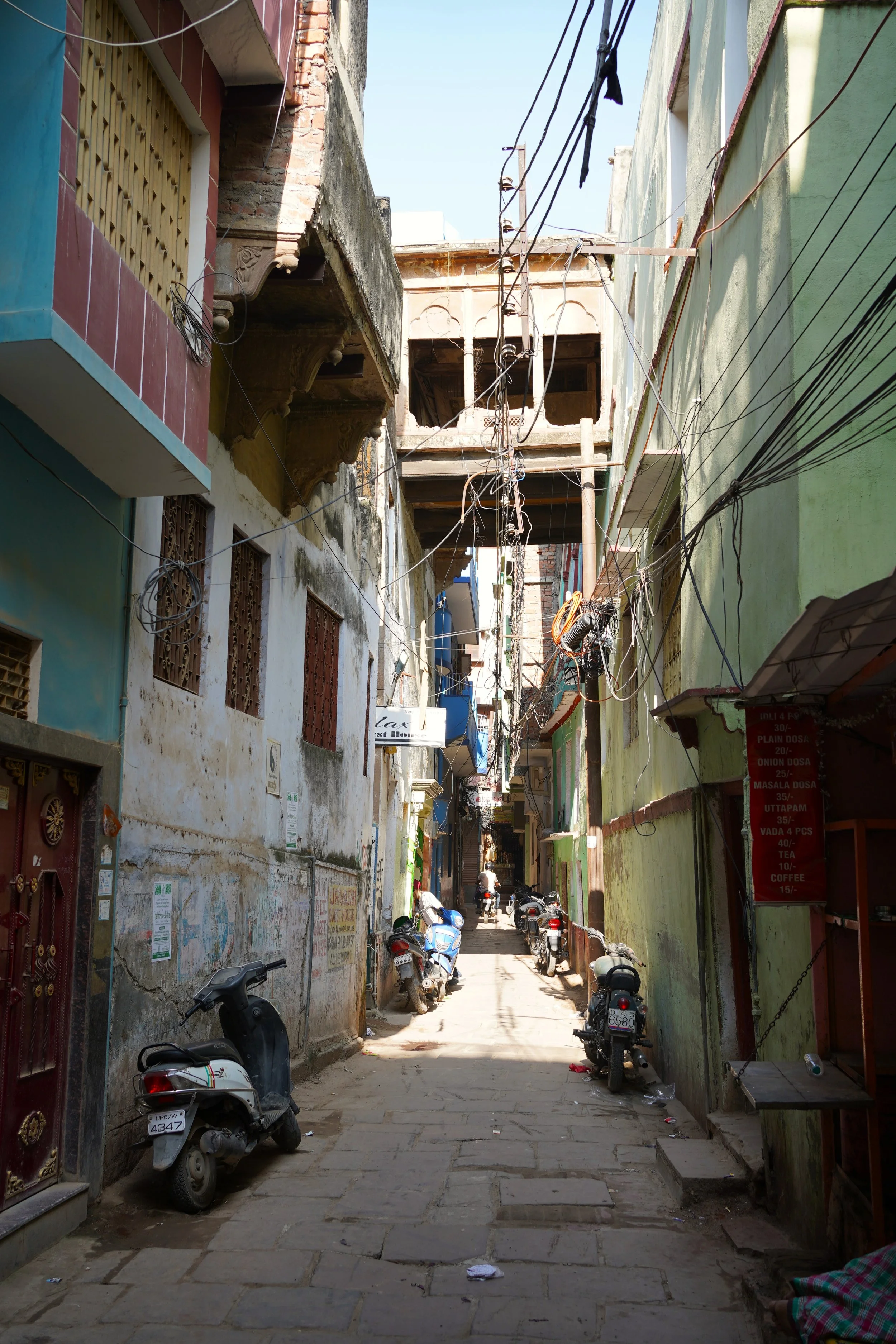1.Identifying the hottest areas in the city and mapping of access to green and blue spaces via satellite data and GIS
2.Adding social and contextual data via interviews, local observations, and other data sources like the Census
4.We analyse our gathered data from the tree distribution process to improve our operations and our culturally-sensitive outreach and education campaign.
3.Using our local networks, we deliver the trees, a survey, and an information package to the most vulnerable communities in the city
The Rationale
Longer and more severe heatwaves in India pose increasing health risks, including death, for urban residents. Small and mid-sized native trees on rooftops could be a scalable, low-cost, and bottom-up adaptation measure.
Urbanization and Increasing Urban Heat in India
We have entered the “Century of the City”, as more than half of the global population now lives in cities, compared to only 10% in 1900 (Grimm et al. 2008; Seto, Sánchez-Rodríguez, and Fragkias 2010; Sun et al. 2020). By 2050, 68% or more of the global population might live in cities, with most of this growth in urban population happening in low- and lower-middle-income countries (Sun et al. 2020). The last Census in India in 2011 categorized 31% of the Indian population as urban, with estimations projecting 40% of Indians being urban dwellers by 2036 (Kouamé 2024). This rapid urbanization on a global scale and within India has a big impact on humans and the environment within urbanizing areas and in areas far beyond the city´s boundaries. In India, the impacts of urbanization include an increase in built-up area of 47% between 2000 and 2015 in India´s 10 biggest cities, which led to a 15% decrease in urban surface water (Goswami et al. 2022). When it comes to green space and urbanization in India, a decreasing trend can be observed as well, leading to only 0.12m2 of green space per person left in for example Mumbai, while the UN recommends 9m2 of urban green space per capita (Gangopadhyay and Balooni 2012; Imam and Banerjee 2016).
One of the effects of urbanization and the connected loss of green and blue spaces is the so-called Urban Heat Island Effect (UHI). This urban microclimate describes higher air and surface temperatures inside the city, relative to the non-urban surroundings of the city (Masson et al. 2020). The UHI occurs because of land-use changes, stored solar energy in building materials, radiative trapping because of angled and vertical surfaces, changes in air circulation, and human sources of heat in cities, leading to an average increase in temperature of 1-3 Degrees Celsius, while up to 10 Degrees Celsius have been observed in India and elsewhere (Liu and Niyogi 2019; Masson et al. 2020; Mohan, Bhati, and Sati 2022). With most cities vulnerable to extreme heat lying in the Global South, urbanized areas are often outpacing emissions-driven global warming when it comes to an average temperature increase (Huang et al. 2019; Kabano, Lindley, and Harris 2021). While 2024 is expected to be the first year over 1.5 Degrees Celsius of average global warming, relative to pre-industrial temperatures, Bangalore for example already shows an increase between 2 and 2.5 Degrees Celsius between 1973 and 2009 (Ramachandra and Kumar 2010).
The interconnected trends of increasing urbanization, population growth, global warming, and loss of urban green and blue spaces in India and other parts of the Global South are leading to negative health impacts, including death, for urban residents. High air humidity, further increasing due to global warming, and air pollution, both present in many Indian cities, contribute to human vulnerability to extreme heat (Rahman et al. 2022; Bu et al. 2024). As the UHI effect is especially pronounced during the night, unusually hot nights increase the mortality risk from a heatwave by 50%, compared to days without unusually hot nights (He et al. 2022).
In India, between 2017 and 2021, compared to 2000-2004, heat-related deaths increased by 55% (Romanello et al. 2022). With an estimated 14.7% increase in mortality during heatwaves in all of India, a study finds this number to be slightly lower at 12% for the case study city of Varanasi (Singh et al. 2019; de Bont et al. 2024). Interviewing members of the community of the traditional corpse cremators in Varanasi, they report a much higher number of more than twice as many people getting cremated after particularly hot days, during the loo, the hot and dry wind blowing over the Indo-Gangetic Plain in summer (Personal Communication). With official numbers speaking of 40,000 recorded cases of heat stroke, but only 110 deaths, in India in 2024, experts like the former head of the Indian Institute of Public Health speak of an undercounting of heat-related deaths (Arasu 2024). Independent studies attribute a minimum of 1116 deaths in India annually to heatwaves (de Bont et al. 2024). Even under the lowest emission scenario, heatwaves in India are projected to increase in duration and frequency by around 8 times by 2050, with further studies suggesting a coupled increase in heat-related deaths (Chen et al. 2022; Ravindra et al. 2024). This is a clear call to action in terms of mitigation, adaptation, and the implementation of resilience measures to protect urban residents in India from the increasing heat. Failure to do so will result in an increasing number of deaths and other negative heat-related impacts, which might translate into wider negative social, political, and economic implications.
The Rationale Behind Trees on Rooftops as Potential Remedy
The case study demonstrates how urban green and blue spaces can cool down urban environments, which can save lives. The case also shows how a deeper analysis of social, economic, and political factors can reveal vulnerabilities, unseen by LST analysis. Analyzing the Geographic Information System (GIS) data collected for Varanasi, it can be estimated, that the city lost around 75% of its water area in the last 200 years. However, only around 5% of its garden and park area was lost in the last 200 years, a closer look reveals an increase in the number of unconnected parcels by 156%, implying a fragmentation and severe decrease in the size of green spaces throughout the city, which can be confirmed by the GIS data. The literature generally confirms the positive role of urban blue and green spaces in mitigating the effects of the UHI (Susca, Gaffin, and Dell’Osso 2011; Zhou, Wang, and Cadenasso 2017; Peng et al. 2020; Knight et al. 2021; Yao et al. 2023; Cheval et al. 2024). Increasing green infrastructure can also have positive effects on urban air pollution mitigation (Wu et al. 2024).
In Varanasi, and other places in India, for example, the Neem, Banyan, or Peepal tree, have a great spiritual and cultural role (Personal Communication). A look into Varanasi´s history unveils a vision for re-greening the city. Many locals know the city also under the name Anandavan, which means Forest of Bliss. And indeed, where the city stands today, once stood a mighty forest with many groves and ponds (Eck 1993; Gogate 2023).
While the regional Heat Wave Action Plan 2024 acknowledges “green roofs” as a potential remedy, I didn´t come across any major state-sponsored implementation efforts of such (UPSDMA 2024). Therefore, reviving the Anandavan might rather be put in the hands of local civil society and spiritual organizations, following a bottom-up approach. Once people start to organize around an environmental topic, government and even international organizations step in, as happened before with many initiatives to clean the Ganga River. Because of that, a newspaper article to create general awareness and inform and motivate the readers is the outreach platform of choice.
The recommendation involves planting small and mid-sized native trees on the many flat roofs in the hottest areas of the city, so they shade the rooftops, provide moisture, contribute to filtering air pollution, and, in the case of for example mango trees, provide healthy food for the often-underserved residents. A small tree in a plastic pot costs around 2-5 USD in local nurseries (Personal Communication). Inspired by the newspaper article, residents can either buy the trees by themselves, educate others, get organized in community planting projects, or receive a tree from a spiritual organization´s campaign. Of course, greening the roofs will not cool down the area as a forested area like the Cantonment does, but it is a relatively low-cost, community-based, bottom-up, culturally sensible, scalable, intervention, that could save lives. A Nature study from India indicates that rooms underneath a green rooftop could be cooled down between 4 and 11 Degrees Celsius, compared to fully exposed roofs (Visvanathan et al. 2024).
References
Arasu, Sibi. 2024. “India Is Likely Undercounting Heat Deaths, Affecting Its Response to Increasingly Harsh Heat Waves.” AP News. July 4, 2024. https://apnews.com/article/india-heat-wave-death-toll-undercounting-climate-change-f54464851e45fbc4019caededa90ce12.
Bont, Jeroen de, Amruta Nori-Sarma, Massimo Stafoggia, Tirthankar Banerjee, Vijendra Ingole, Suganthi Jaganathan, Siddhartha Mandal, et al. 2024. “Impact of Heatwaves on All-Cause Mortality in India: A Comprehensive Multi-City Study.” Environment International 184 (February):108461. https://doi.org/10.1016/j.envint.2024.108461.
Bu, Yaqin, Zhaobin Sun, Yan Tao, Xiuge Zhao, Yuxin Zhao, Yinglin Liang, Xiaoyi Hang, and Ling Han. 2024. “The Synergistic Effect of High Temperature and Relative Humidity on Non-Accidental Deaths at Different Urbanization Levels.” Science of The Total Environment 940 (August):173612. https://doi.org/10.1016/j.scitotenv.2024.173612.
Chen, Huiqi, Liang Zhao, Liangliang Cheng, Yali Zhang, Huibin Wang, Kuiying Gu, Junzhe Bao, et al. 2022. “Projections of Heatwave-Attributable Mortality under Climate Change and Future Population Scenarios in China.” The Lancet Regional Health - Western Pacific 28 (November):100582. https://doi.org/10.1016/j.lanwpc.2022.100582.
Cheval, Sorin, Vlad-Alexandru Amihăesei, Zenaida Chitu, Alexandru Dumitrescu, Vladut Falcescu, Adrian Irașoc, Dana Magdalena Micu, et al. 2024. “A Systematic Review of Urban Heat Island and Heat Waves Research (1991–2022).” Climate Risk Management 44 (January):100603. https://doi.org/10.1016/j.crm.2024.100603.
Eck, Diana L. 1993. Banaras: City of Light. First publ. ba Penguin Books India. New Delhi: Penguin Books India.
Gangopadhyay, Kausik, and Kulbhushan Balooni. 2012. “Technological Infusion and the Change in Private, Urban Green Spaces.” Urban Forestry & Urban Greening 11 (2): 205–10. https://doi.org/10.1016/j.ufug.2011.12.003.
Gogate, Mahesh. 2023. The Sacred Waters “of” Varanasi: The Colonial Draining and Heritage Ecology. New Delhi: Manohar.
Goswami, Sahana, Samrat Basak, Aakash Malik, and Raj Bhagat Palanichamy. 2022. “Urban Blue-Green Conundrum: A 10-City Study on the Impacts of Urbanization on Natural Infrastructure in India.” World Resources Institute, December. https://doi.org/10.46830/wriwp.19.00062.
Grimm, Nancy B., Stanley H. Faeth, Nancy E. Golubiewski, Charles L. Redman, Jianguo Wu, Xuemei Bai, and John M. Briggs. 2008. “Global Change and the Ecology of Cities.” Science 319 (5864): 756–60. https://doi.org/10.1126/science.1150195.
He, Cheng, Ho Kim, Masahiro Hashizume, Whanhee Lee, Yasushi Honda, Satbyul Estella Kim, Patrick L. Kinney, et al. 2022. “The Effects of Night-Time Warming on Mortality Burden under Future Climate Change Scenarios: A Modelling Study.” The Lancet Planetary Health 6 (8): e648–57. https://doi.org/10.1016/S2542-5196(22)00139-5.
Huang, Kangning, Xia Li, Xiaoping Liu, and Karen C Seto. 2019. “Projecting Global Urban Land Expansion and Heat Island Intensification through 2050.” Environmental Research Letters 14 (11): 114037. https://doi.org/10.1088/1748-9326/ab4b71.
Imam, Aabshar U. K., and Uttam Kumar Banerjee. 2016. “Urbanisation and Greening of Indian Cities: Problems, Practices, and Policies.” Ambio 45 (4): 442–57. https://doi.org/10.1007/s13280-015-0763-4.
Kabano, Peter, Sarah Lindley, and Angela Harris. 2021. “Evidence of Urban Heat Island Impacts on the Vegetation Growing Season Length in a Tropical City.” Landscape and Urban Planning 206 (February):103989. https://doi.org/10.1016/j.landurbplan.2020.103989.
Knight, Teri, Sian Price, Diana Bowler, Amy Hookway, Sian King, Ko Konno, and Raja Lorena Richter. 2021. “How Effective Is ‘Greening’ of Urban Areas in Reducing Human Exposure to Ground-Level Ozone Concentrations, UV Exposure and the ‘Urban Heat Island Effect’? An Updated Systematic Review.” Environmental Evidence 10 (1): 12. https://doi.org/10.1186/s13750-021-00226-y.
Kouamé, Tano. 2024. “Gearing up for India’s Rapid Urban Transformation.” World Bank. 2024. https://www.worldbank.org/en/news/opinion/2024/01/30/gearing-up-for-india-s-rapid-urban-transformation.
Liu, Jie, and Dev Niyogi. 2019. “Meta-Analysis of Urbanization Impact on Rainfall Modification.” Scientific Reports 9 (1): 7301. https://doi.org/10.1038/s41598-019-42494-2.
Masson, Valéry, Aude Lemonsu, Julia Hidalgo, and James Voogt. 2020. “Urban Climates and Climate Change.” Annual Review of Environment and Resources 45 (1): 411–44. https://doi.org/10.1146/annurev-environ-012320-083623.
Mohan, Manju, Shweta Bhati, and Ankur Prabhat Sati. 2022. “Chapter 11 - Urban Heat Island Effect in India: Assessment, Impacts, and Mitigation.” In Global Urban Heat Island Mitigation, edited by Ansar Khan, Hashem Akbari, Francesco Fiorito, Sk Mithun, and Dev Niyogi, 199–250. Elsevier. https://doi.org/10.1016/B978-0-323-85539-6.00007-X.
Peng, Jian, Qianyuan Liu, Zihan Xu, Danna Lyu, Yueyue Du, Ruilin Qiao, and Jiansheng Wu. 2020. “How to Effectively Mitigate Urban Heat Island Effect? A Perspective of Waterbody Patch Size Threshold.” Landscape and Urban Planning 202 (October):103873. https://doi.org/10.1016/j.landurbplan.2020.103873.
Rahman, Md Mostafijur, Rob McConnell, Hannah Schlaerth, Joseph Ko, Sam Silva, Frederick W. Lurmann, Lawrence Palinkas, et al. 2022. “The Effects of Coexposure to Extremes of Heat and Particulate Air Pollution on Mortality in California: Implications for Climate Change.” American Journal of Respiratory and Critical Care Medicine 206 (9): 1117–27. https://doi.org/10.1164/rccm.202204-0657OC.
Ramachandra, T V, and Uttam Kumar. 2010. “Greater Bangalore: Emerging Urban Heat Island.” IIT Bangalore. https://wgbis.ces.iisc.ac.in/energy/paper/Bangalore_heatisland/IISc_TVR_UK_Bangalore_Urban_Heat191209.pdf.
Ravindra, Khaiwal, Sanjeev Bhardwaj, Chhotu Ram, Akshi Goyal, Vikas Singh, Chandra Venkataraman, Subhash C. Bhan, Ranjeet S. Sokhi, and Suman Mor. 2024. “Temperature Projections and Heatwave Attribution Scenarios over India: A Systematic Review.” Heliyon 10 (4): e26431. https://doi.org/10.1016/j.heliyon.2024.e26431.
Romanello, Marina, Claudia Di Napoli, Paul Drummond, Carole Green, Harry Kennard, Pete Lampard, Daniel Scamman, et al. 2022. “The 2022 Report of the Lancet Countdown on Health and Climate Change: Health at the Mercy of Fossil Fuels.” The Lancet 400 (10363): 1619–54. https://doi.org/10.1016/S0140-6736(22)01540-9.
Seto, Karen C., Roberto Sánchez-Rodríguez, and Michail Fragkias. 2010. “The New Geography of Contemporary Urbanization and the Environment.” Annual Review of Environment and Resources 35 (1): 167–94. https://doi.org/10.1146/annurev-environ-100809-125336.
Singh, Nidhi, Alaa Mhawish, Santu Ghosh, Tirthankar Banerjee, and R. K. Mall. 2019. “Attributing Mortality from Temperature Extremes: A Time Series Analysis in Varanasi, India.” The Science of the Total Environment 665 (May):453–64. https://doi.org/10.1016/j.scitotenv.2019.02.074.
Sun, Liqun, Ji Chen, Qinglan Li, and Dian Huang. 2020. “Dramatic Uneven Urbanization of Large Cities throughout the World in Recent Decades.” Nature Communications 11 (October):5366. https://doi.org/10.1038/s41467-020-19158-1.
Susca, T., S. R. Gaffin, and G. R. Dell’Osso. 2011. “Positive Effects of Vegetation: Urban Heat Island and Green Roofs.” Environmental Pollution, Selected papers from the conference Urban Environmental Pollution: Overcoming Obstacles to Sustainability and Quality of Life (UEP2010), 20-23 June 2010, Boston, USA, 159 (8): 2119–26. https://doi.org/10.1016/j.envpol.2011.03.007.
UPSDMA. 2024. “Heat Wave Action Plan 2024.” Lucknow: Uttar Pradesh State Disaster Management Authority. https://upsdma.up.nic.in/2024/Heat_Wave_Action_Plan_2024.pdf.
Visvanathan, Girish, Kailas Patil, Yogesh Suryawanshi, Vishal Meshram, and Shrikant Jadhav. 2024. “Mitigating Urban Heat Island and Enhancing Indoor Thermal Comfort Using Terrace Garden.” Scientific Reports 14 (1): 9697. https://doi.org/10.1038/s41598-024-60546-0.
Wu, Qingyun, Yuhan Huang, Peter Irga, Prashant Kumar, Wengui Li, Wei Wei, Ho Kyong Shon, Chengwang Lei, and John L. Zhou. 2024. “Synergistic Control of Urban Heat Island and Urban Pollution Island Effects Using Green Infrastructure.” Journal of Environmental Management 370 (November):122985. https://doi.org/10.1016/j.jenvman.2024.122985.
Yao, Lingye, David J. Sailor, Xiaoshan Yang, Genyu Xu, and Lihua Zhao. 2023. “Are Water Bodies Effective for Urban Heat Mitigation? Evidence from Field Studies of Urban Lakes in Two Humid Subtropical Cities.” Building and Environment 245 (November):110860. https://doi.org/10.1016/j.buildenv.2023.110860.
Zhou, Weiqi, Jia Wang, and Mary L. Cadenasso. 2017. “Effects of the Spatial Configuration of Trees on Urban Heat Mitigation: A Comparative Study.” Remote Sensing of Environment 195 (June):1–12. https://doi.org/10.1016/j.rse.2017.03.043.





